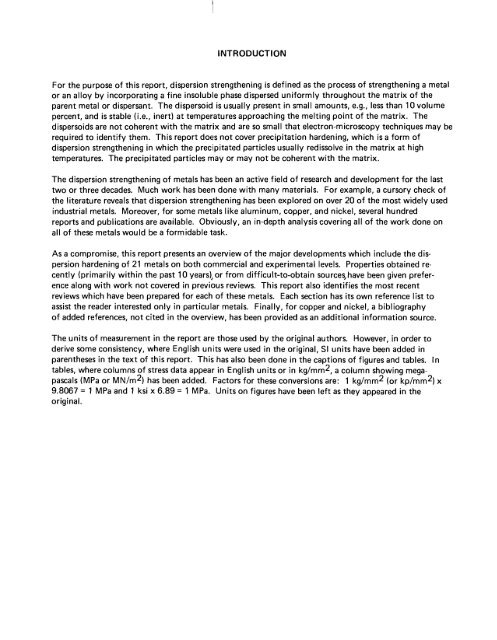INTRODUCTIONFor <strong>the</strong> purpose of this report, <strong>dispersion</strong> streng<strong>the</strong>ning is defined as <strong>the</strong> process of streng<strong>the</strong>ning a metalor an alloy by incorporating a fine insoluble phase dispersed uniformly throughout <strong>the</strong> matrix of <strong>the</strong>parent metal or dispersant. The dispersoid is usually present in small amounts, e.g., less than 10 volumepercent, and is stable (i.e., inert) at tempel'1atures approaching <strong>the</strong> melting point of <strong>the</strong> matrix. Thedispersoids are not coherent with <strong>the</strong> matrix and are so small that electron-microscopy techniques may berequired to identify <strong>the</strong>m. This report does not cover precipitation hardening, which is a form of<strong>dispersion</strong> streng<strong>the</strong>ning in which <strong>the</strong> precipitated particles usually redissolve in <strong>the</strong> matrix at hightemperatures. The precipitated particles mayor may not be coherent with <strong>the</strong> matrix.The <strong>dispersion</strong> streng<strong>the</strong>ning of metals has been an active field of research and development for <strong>the</strong> lasttwo or three decades. Much work has been done with many materials. For example, a cursory check of<strong>the</strong> literature reveals that <strong>dispersion</strong> streng<strong>the</strong>ning has been explored on over 20 of <strong>the</strong> most widely usedindustrial metals. Moreover, for some metals like aluminum, copper, and nickel, several hundredreports and publications are available. Obviously, an in-depth analysis covering all of <strong>the</strong> work done onall of <strong>the</strong>se metals would be a formidable task.As a compromise, this report presents an overview of <strong>the</strong> major developments which include <strong>the</strong> <strong>dispersion</strong>hardening of 21 metals on both commercial and experimental levels. Properties obtained recently(primarily within <strong>the</strong> past 10 <strong>years</strong>t or from difficult-to-obtain sources, have been given preferencealong with work not covered in previous reviews. This report also identifies <strong>the</strong> most recentreviews which have been prepared for each of <strong>the</strong>se metals. Each section has its own reference list toassist <strong>the</strong> reader interested only in particular metals. Finally, for copper and nickel, a bibliographyof added references, not cited in <strong>the</strong> overview, has been provided as an additional information source.The units of measurement in <strong>the</strong> report are those used by <strong>the</strong> original authors. However, in order toderive some consistency, where English units were used in <strong>the</strong> original, 51 units have been added inparen<strong>the</strong>ses in <strong>the</strong> text of this report. This has also been done in <strong>the</strong> captions of figures and tables. Intables, where columns of stress data appear in English units or in kg/mm 2 , a column showing megapascals(MPa or MN/m 2 ) has been added. Factors for <strong>the</strong>se conversions are: 1 kg/mm 2 (or kp/mm 2 ) x9.8067 = 1 MPa and 1 ksi x 6.89 = 1 MPa. Units on figures have been left as <strong>the</strong>y appeared in <strong>the</strong>original.
BACKGROUND INFORMATIONWhat we now designate as "<strong>dispersion</strong>-streng<strong>the</strong>ned metals" probably originated with <strong>the</strong> developmentof "ductile tungsten". (1) Ductile tungsten lamp filaments were developed more than 65 <strong>years</strong> <strong>ago</strong> at <strong>the</strong>General Electric Laboratories by C. G. Fink and W. D. Coolidge.(2) The 1913 patent(3) on <strong>the</strong> processmentioned a product "containing additional material which will prevent coarse crystallization of <strong>the</strong>tungsten at high temperatures". Shortly <strong>the</strong>reafter Fink (4) indicated that "large quantities of drawnwire, flexible and strong, are being daily produced and used as filaments in incandescent lamps". Healso suggested fur<strong>the</strong>r applications.The effect of Th02 additions to tungsten was studied by Zay Jeffries. (5) He observed that <strong>the</strong>seadditions retarded grain growth at high temperatures and consequently resulted in longer lives for <strong>the</strong>filaments. At that time, thoriated tungsten wires containing about 0.7 percent Th02 were mainlyused for incandescent lamps. Wires for cathodes usually contained 1.5 percent Th02. Additions ofTh02 were limited to a maximum of about 2 percent since it was difficult to work tungsten with higherTh02 contents. These alloys were produced from a mixture of W03 and an aqueous solution ofTh(I\J03)4 which was dried, pulverized and sifted. The W03 was reduced to tungsten by sintering <strong>the</strong>mixture in hydrogen. The Th02 remained stable through <strong>the</strong> sintering process. However, Fink found(6)that if rods of ductile tungsten were heated high enough in an oxygen-free atmosphere, <strong>the</strong> tungstenand thorium alloyed.In 1930, Smith(7) proposed internal oxidation of powders as a means of <strong>dispersion</strong> streng<strong>the</strong>ning. Theprocess was later applied by Rhines(8) and Meijering(9) using copper and silver alloys and by De Jong(10)on beryllium and copper alloys.The use of an inert oxide as a dispersoid was not realized until later, as reported in a historical reviewby Goetze!. (11) He discusses what may have been forerunners of <strong>dispersion</strong>-streng<strong>the</strong>ned aluminumgoing back to 1940 and possibly even to a report by Masing in 1909. In 1942, a patent was issued on<strong>dispersion</strong>-streng<strong>the</strong>ned (OS) Pt-Th02(12), as a logical extrapolation of techniques used on DS-W-Th02for <strong>the</strong> lamp industry.Around 1946, Irman(13) developed an Al203-streng<strong>the</strong>ned aluminum named SAP, an acronym forei<strong>the</strong>r "sintered aluminum powder" or "sintered aluminum product". SAP is a registered trade name ofAluminum Industrie A.G. of Neuhausen a. Rheinfall, Switzerland. The manufacturing process for SAPconsists primarily of preparing <strong>the</strong> aluminum powder by a grinding process in a special atmosphere toproduce an oxide film about 100 Angstroms (0.01 micron) thick on <strong>the</strong> surface of <strong>the</strong> powder particles.Fur<strong>the</strong>r dry grinding breaks up <strong>the</strong> oxide-coated particles to produce a powder consisting of isometricparticles that are not only oxidized on <strong>the</strong> surface, but also contain fine oxide particles in <strong>the</strong> interior.After compacting, sintering, and hot working, <strong>the</strong> resultant material contains a fine <strong>dispersion</strong> of verysmall particles of A1203' This SAP process was <strong>the</strong> <strong>first</strong> of <strong>the</strong> mechanical, or nonchemical, processesused successfully to provide a uniform <strong>dispersion</strong> of very small particles of oxide in a metal. Manyinvestigators <strong>the</strong>n decided to try adding o<strong>the</strong>r refractory oxides, to obtain a similar effect. The process,of course, is confined to those metals or alloys that form stable oxides that will serve as dispersoids.The <strong>dispersion</strong> of AI203 conferred strength to <strong>the</strong> SAP system up to <strong>the</strong> melting point of <strong>the</strong> aluminummatrix. SAP was <strong>the</strong> <strong>first</strong> <strong>dispersion</strong>-streng<strong>the</strong>ned material designed as a structural load-bearing system.Considerable research has been done by companies in <strong>the</strong> U.S. and elsewhere to fur<strong>the</strong>r improve thismaterial since it <strong>first</strong> appeared on <strong>the</strong> market. SAP alloys, however, have not found widespread usage.* References are listed at <strong>the</strong> end of this section and each section in <strong>the</strong> report.2
















